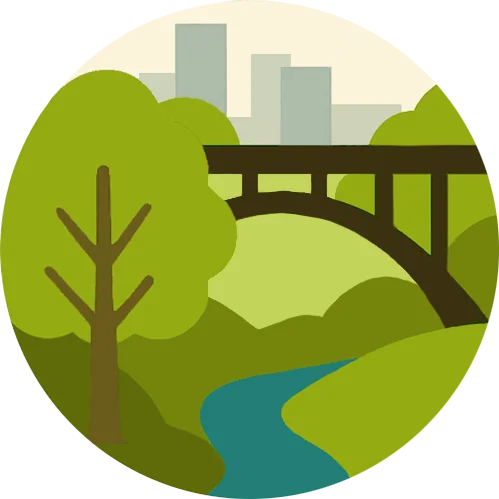Our vision: a well-maintained woodland environment that provides a green haven for midtown Toronto. Our plan: a set of goals for restoration and remediation met through a combination of City investment and private funds. Our plan provides a wonderful opportunity to meet the aspiration of the Ravine Strategy ‘for people to connect with nature and the city’s rich history’, reviving a degrading link in the city’s trail network, inviting residents and visitors to explore and connect.
Rebuilding the Trail Network
The Vale of Avoca offers an exceptional opportunity to escape the city’s urban environment and connect with nature. Access points up and down the ravine provide easy access to the ravine for a number of physically separated communities – Deer Park, Summerhill, North and South Rosedale, Moore Park, Davisville, and the Bloor/Yorkville corridor. This ease of use opens opportunities for community-building through shared experiences in an unhurried natural environment.
A well-designed north-south link that is compatible with its woodland setting will complete a 7km loop trail connecting the Yonge corridor to the Brickworks and Don Valley. This “little loop” has excellent connections to the city-wide trail network, including the Beltline, Lower Don, and City Loop routes. Taken together the footpaths combine to create walking loops from each of the access points through some of the most scenic parts of the ravine. Congenial surfaces will make the passage less hazardous for users while keeping them on the trails rather than trampling the fragile ecosystem.
Protecting the Ravine from Erosion
The remediation of ravine erosion is a foundational component of this plan and will need to address the effects of past erosion on the stream bed, retaining walls, and ravine slopes. Left unaddressed, the condition of the ravine will continue to deteriorate, with escalation of damage to the area and of the cost of its remediation. The hydromorphic state of the ravine has been analyzed in a Geomorphic Systems Master Plan (‘GSMP’) commissioned by Toronto Water, which was made public in early spring 2025. This study will provide a foundation for the design of stream remediation work throughout the open section of the ravine.
Future work plans should take an expansive view of erosion control requirements, so that remedies will safeguard the ravine integrity generally, not just address specific problems in isolation. We suggest that integrated plans be developed to minimize ravine closings and avoid duplicated costs. A minimalist and reactive approach to ravine problems will continue to waste invested resources.
Restoring and Protecting Ravine Ecology
A major ecological challenge for Yellow Creek is the management of invasive species infestations. A range of invasives has been identified that have a major impact on the ravine’s biodiversity and ecological heath. These will need to be addressed over time by a combination of professionals and by enlisting community groups dedicated to preserving and restoring Toronto’s green health. Without ongoing maintenance, ecological capital projects quickly revert to their former state.
